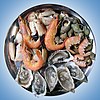Iridescent shark

The iridescent shark (Pangasianodon hypophthalmus) is a catfish that is a native to the rivers across Southeast Asia. They are not sharks, but they do look like small sharks.
They are found over Mekong Basin and the Chao Phraya River areas and used for food there. The fish are marketed as swai in the United States. They are very similar to the US catfish. It has also been introduced into other river basins as a food source.
Description[change | change source]
Adults reach up to 130 cm (4.3 ft) in length and can weigh up to a maximum of 44 kg (97 lb). They have a shiny, iridescent color that gives these fish their name. Large adults are gray. The fins are dark gray or black. Juveniles have a black stripe along the lateral line and a second black stripe below the lateral line.
Distribution[change | change source]
Iridescent sharks come from the large rivers Chao Phraya and Mekong in Asia. They have been introduced into other rivers for aquaculture.
Diet and behavior[change | change source]
The iridescent shark is an omnivorous species, and does not require much animal protein in its diet. Typical grading sizes are 3–5 oz (85–140 g), 5–7 oz (140–200 g), and 7–9 oz (200–260 g). Its diet consists of other fish, plant matter, and crustaceans.
These fish are fast enough to catch and eat even active fish like tetra fish and guppies.
In the aquarium[change | change source]
Juvenile iridescent sharks are sold as pets for home aquariums, but they are not easy fish to keep. Iridescent sharks are schooling fish that prefer groups. They live in rivers, and are active fish that need space. Iridescent sharks require a tank size of at least 12 m (39 ft) to develop naturally. Schools require even larger tanks.
Related pages[change | change source]
References[change | change source]
- Vidthayanon, C.; Hogan, Z. (2011). "Pangasianodon hypophthalmus". IUCN Red List of Threatened Species. 2011: e.T180689A7649971. doi:10.2305/IUCN.UK.2011-1.RLTS.T180689A7649971.en. Retrieved 19 November 2021.
- "Appendices | CITES". cites.org. Retrieved 2022-01-14.
- Axelrod, Herbert, R. (1996). Exotic Tropical Fishes. T.F.H. Publications. ISBN 0-87666-543-1.
Further reading[change | change source]
- "Status of the Mekong Pangasianodon Hypophthalmus Resources, Mekong River Commission. July 12, 2002 – via Google Books.


